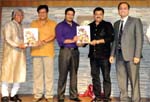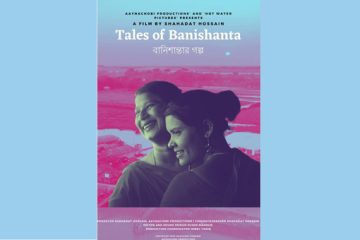 Indira Gandhi Cultural Centre in association with Shadhona – A Center for Advancement of South Asian Culture and the State Bank of India in Bangladesh organised a launch ceremony of ‘A Directory of Bengali Cinema’ and screening of Pundit Uday Shankar’s film Kalpana on Thursday at the centre’s auditorium.
Indira Gandhi Cultural Centre in association with Shadhona – A Center for Advancement of South Asian Culture and the State Bank of India in Bangladesh organised a launch ceremony of ‘A Directory of Bengali Cinema’ and screening of Pundit Uday Shankar’s film Kalpana on Thursday at the centre’s auditorium.
A Directory of Bengali Cinema is a fact list of the glorious 100 years of Bengali cinema. Kazi Anirban, grandson of national poet Kazi Nazrul Islam, and Parimal Roy, an associate of late Oscar-winning Bengali director Satyajit Roy, undertook the painstaking job of assimilating 100 years’ harvest of Bengali cinema. The directory encompasses facts and booklets starting from Raja Harishchandra, released back in 1917 till today’s Bengali cinema.
Sandeep Chakravorty, Deputy High Commissioner of the High Commission of India, Dhaka, Pijush Bandhopadhyay, managing director of Bangladesh Film Development Corporation, actor Ferdous Ahmed and Kazi Anirban were present at the book launch programme among others.
‘The directory includes films released in the then undivided Bengal and the now Pashchimbanga. It also includes some films made jointly by Bangladeshi and Indian directors’, Kazi Anirban told New Age.
‘It is indeed a great industrious work. I thank Anirban and Parimal for presenting such a valuable directory’, said Pijush Bandhopadhyay.
Following the book launch, legendary dance maestro Uday Shankar’s film Kalpana (Imagination) was screened. Written and directed by Uday Shankar, the film was released in 1948.
The film Kalpana is autobiographical and penned by Uday Shankar who, along with his wife Amala Shankar, enacted the major roles in the film. The story revolves around a young dancer’s dream of setting up a dance academy, a reflection of Shankar’s own vision to set up an academy.
Kalpana’s autobiographical plot is interspersed with scenes from an imaginary world. After a point, reality intertwines with the surreal (even for the audience), and it becomes difficult to separate one from the other. The story is narrated almost entirely in dance form, with no less than 82 dance sequences incorporated in it.
‘We should evaluate the film in its time. Uday Shankar was searching the root of Indian culture, and Kalpana, above all, is a depiction of this search’, opined Lubna Marium, artistic director of Shadhona.
-With New Age input

